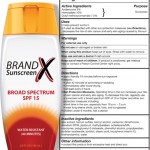Did you know that the FDA issued new guidelines last week on sunscreen? With summer upon us, I thought we could all use a little refresher course on sunscreen. Here in Texas, with the temperatures being unusually high for the past month, I fear it’s only going to get worse as that sun beats down on us. I learned the hard way years ago when I developed what my dermatologist referred to as “Texas neck”. Even if your only exposure to the sun is while you are inside of your car, you need to apply sunscreen.
I found this article from the Huffington Post that seems short and succinct, because I know you all just want to get out to the pool.
The Food and Drug Administration’s new sunscreen rules, announced earlier this week, aim to change that. In a year’s time, a few simple tweaks right on labels should make it easier for consumers to parse out exactly what’s what. Among them:
- Products will no longer be able to be labeled “waterproof” or “sweatproof.” Instead, they will have to list how many minutes they can last in the face of moisture. Also gone? The word “sunblock.” Too misleading.
- Only sunscreens found, in the lab, to protect equally against UVA and UVB rays will carry a “broad spectrum” designation. (The current SPF ratings that most consumers rely on refer to how well sunscreen stands up to UVB rays only.) In addition, only sunscreens that are SPF 15 and higher will be able to claim they reduce the risks of skin cancer and aging.
But before those changes kick in, there’s no need to be stumped by sunscreens. Dermatologists say there are a few main things you can look for when shopping.
Check What’s Inside
First, look for ingredients like Zinc oxide, Avobenzone or Titanium dioxide, which ensure broad spectrum coverage.
Need it even simpler still?
“My personal bias would be towards zinc, because just the one chemical gives full, broad protection,” said Dr. Raja Sivamani, a resident physician in dermatology at UC Davis.
Get The Right Protection
Second, look for a sunscreen that has an SPF of 30 or higher, said dermatologist Dr. Thomas Rohrer. He said some people question whether anything higher than 15 really makes a difference — but his vote is “yes.”
“Nobody uses the amount of sunscreen that people do in testing in real life,” he said. “So it does help to go up to an SPF of 30, or even beyond.”
Be Sun Smart
Both derms stressed that the biggest factors may not be determined in the drug store aisle, but when people are out in the world. Avoiding the peak hours and wearing protective clothing are really the first lines of defense, Sivamani explained.
Slather It On — All Day Long
Also? Reapply, reapply, reapply, even if using a water resistant formula and especially if you’ve picked a spray. Roher said that people who use sprays may get a “false sense of security” by just misting themselves, meaning they don’t get the same volume of sunscreen that they might with a cream or gel.
“You need a strong SPF, but the most important thing is to apply a lot of sunscreen and apply it frequently,” he said.
So, to recap, if you are at the lake, beach, pool, sporting event, outside doing yard work, or even driving a car, use sunscreen and reapply throughout the day. AND, add to your smart things to do in the heat to hydrate yourself, and not with beer or margaritas but water. I am not going to recommend any sunscreen products at this time because a search of the one I thought had the most protection, has all the buzz words the FDA says can no longer be used. I certainly don’t want to recommend a product and then have you get burned and blame me. Let me know what sunscreen you use and why in the comments section.







